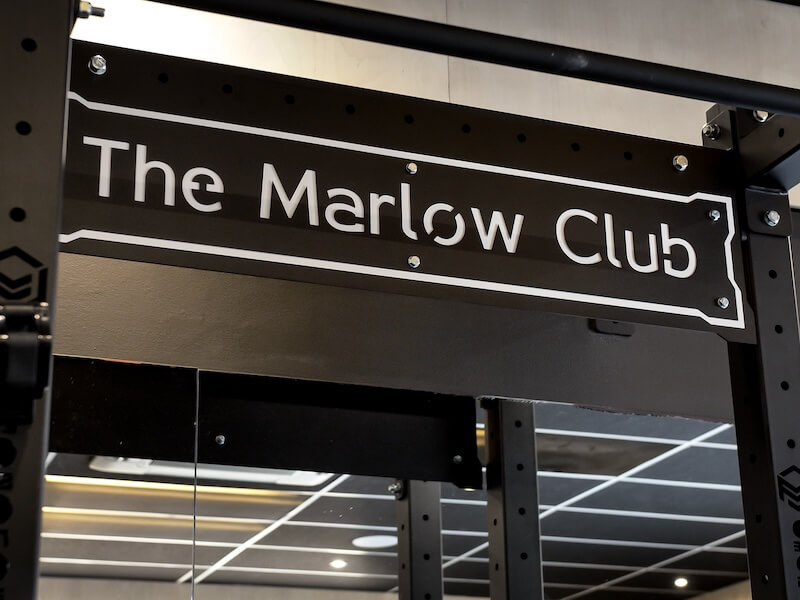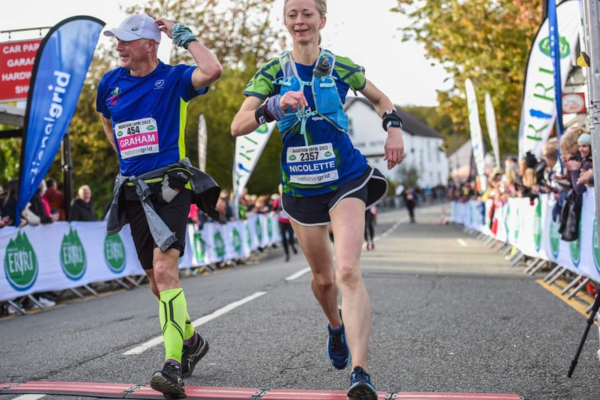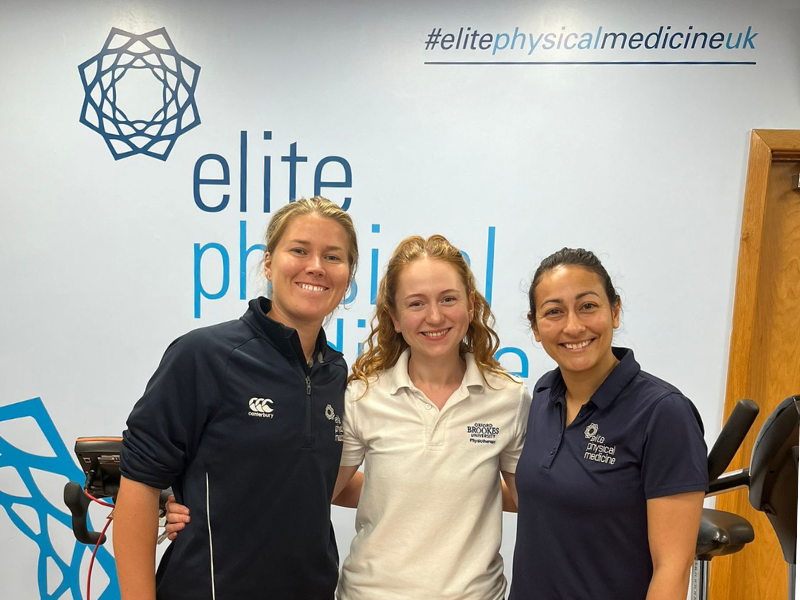Months, or even years, of hard work and consistent training, will culminate on Sunday 23rd April at the 2023 London Marathon.
But for some, the final weeks of race preparation come with more than just nerves and excitement.
Unwanted injuries, annoying niggles and painful twinges bring doubts about whether setting foot over that start line is such a good idea. So how do you know when it’s safe to ignore these warning signs and push on, or whether you really ought to pull out and defer to next year?
Long-time client and friend of the clinic, Mike Sutliff, was in this exact predicament in February as he prepared to run the Paris Marathon on 2nd April and suffered a suspected tear in his calf with only 8 weeks to go. Faced with a tough decision about whether to risk the race or not, Mike called Andy McCrea for advice.
Spoiler alert!
47-year-old Mike not only ran the Paris marathon pain-free on 2nd April 2023, he crossed the finish line in an impressive 3 hours 29 minutes, knocking 19 minutes off his previous record round the French capital in 2015.
Here’s how he did it (and how Elite can help if you’re going through something similar)…
1. DO keep calm and ice it!
After steadily building up miles, running uphill and down dale across the Chilterns without any issues, Mike’s calf “pinged” on a treadmill session.
He panicked that if his calf muscle had ruptured, his chances of completing the race were virtually nil. Andy’s first advice when Mike called with the news was to ice the injury that same evening.

Finisher! Mike Sutliff ran the Paris marathon in under 3.5 hours
Andy said:
“Ice is Step One when it comes to damage limitation for most muscular injuries. If you think you’ve pulled something or suspect a torn muscle, ice your injured leg before bed, try to stay relaxed and get a good night’s sleep.
The combination of ice therapy and the amazing repair work your body can do while you sleep will give you the best chance of minimising the damage. You might find in the morning it doesn’t seem quite so serious.”
2. DON’T reach for the ibuprofen just yet
Ibuprofen is an anti-inflammatory drug which reduces our experience of pain by limiting the body’s natural response to injury – inflammation. If your discomfort is bearable enough that you can go to sleep without taking painkillers, you may be better to allow the initial inflammatory response to do what it’s designed to do: flood the injured area with blood cells that will begin to carry out important repair work.
According to an NHS source:
“Anti-inflammatory medicines should only be considered for use 48 hours after an injury has occurred. If they’re used before this time, they may affect the healing process in some conditions.”
3. DO get an ultrasound scan
To assess the level of damage and advise Mike on his next steps, Andy used his experience as a diagnostic sonographer.
Musculoskeletal Ultrasound imaging uses sound waves to produce pictures of muscles, tendons, ligaments and joints throughout the body.
By scanning runners, the team at Elite are able to visualise the size and location of a muscular tear, as well as the tear grade and the amount of fluid present.
Ultrasound images enable a working diagnosis and prognosis, which can help our clinicians guide runners on their return to exercise.
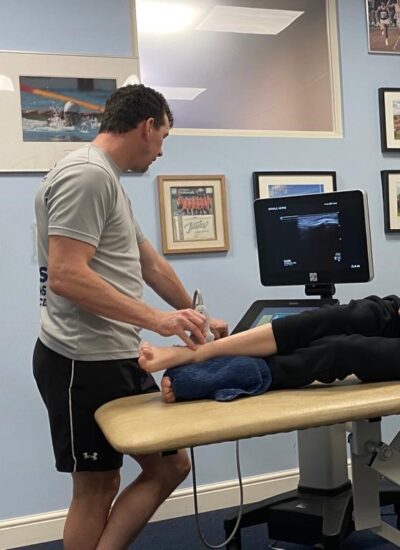
Andy conducts an ultrasound scan
4. DON’T go for a massage without checking with your physio first
Mike had a massage booked with Nicolette on the Thursday before his Sunday race, as he knew it can be advantageous for athletes to include massage in their pre-habilitation strategy. Unfortunately, for muscular tears, massage isn’t the right type of treatment.
Andy says:
“Massage increases bloodflow to the target area, which in many circumstances is helpful, but not in the case of an acute muscular tear. If the muscle has been damaged in the last 48-72 hours there may still be some internal bleeding, which massage will exacerbate. This can prolong recovery. It’s best to have your injury fully assessed by a physiotherapist before going ahead with any massage treatments.”
5. DO give yourself permission to rest
It can be heartbreaking to have stuck determinedly to a training plan month after month, only to miss those final few sessions. As we approach race day, many runners will have already banked their ‘long runs’ and will be tapering down their miles during this final fortnight before the London event, but Mike’s injury occurred before he’d reached the longer distances.
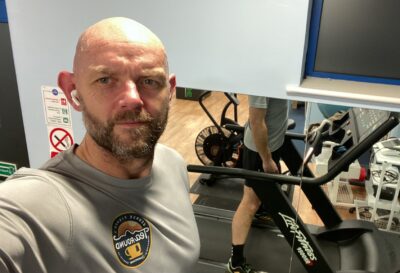
Mike training in Elite’s rehab gym
Mike said:
“As my leg started to feel better it was tempting to try it out and get back to my training plan as soon as possible. But Andy advised me not to run until I had built strength up in my calf.
I focused on maximising my sleep and my nutrition and staying positive. Once I was able to complete a set of 30 calf raises, Andy gave me confidence that my strength endurance was adequate to begin training again.”
6. DON’T give up hope
Have faith in yourself and your body! Your target time might need revising a bit, but if you’ve followed all of the steps so far, the biggest game-changer of all could be your mindset.
Mike said:
“Before I hurt my calf I was feeling great about the marathon. The injury I sustained on the treadmill felt like a massive setback and I considered cancelling my trip altogether. It was devastating to have put in so much effort and potentially not even get the chance to see what I could do.
The team at Elite were so supportive and encouraging, they helped me look back at everything I’d accomplished in the months leading up to the race and this allowed me to remain optimistic, despite having to miss a month of training at a crucial stage in my programme.”
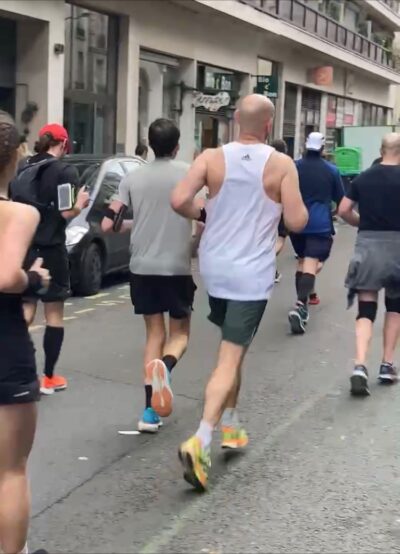
Mike going strong at 40km
I knew I still had plenty of miles in my legs, I’d dropped a few kilos and got myself up to race pace. I wasn’t ready to hang my trainers up, so for a month I stayed off my feet and revised my target time to something that felt more realistic.
Once I’d come to terms with the fact I wasn’t going to get a PB, I was able to relax and look forward to the race again. Whilst it wasn’t the fastest marathon I’ve run, I did get a PB for Paris!”
If you’re running the London marathon, supporting a runner, or just going along to soak up the atmosphere, you can download the event guide here.
To get a personalised pre-hab plan for your next event, please contact the clinic.

